
Strawberry U-Pick Orchards in Northeastern Washington State in 2024, by county
Below are the U-Pick orchards and farms for strawberries that we know of in this area.
Not all areas of a state have strawberries farms that are open to the public. If you know of any others, please tell us using the add a farm form!
Remember to always check with the farm's own website or Facebook page before you go - or call or email them if they don't have a website or Facebook page. Conditions at the farms and crops can change literally overnight, so if you want to avoid a wasted trip out there - check with the farm directly before you go! If I cannot reach them, I DON'T GO!
PLEASE report closed farms, broken links and incorrect info using the "Report Corrections" form below.
Okanogan County
- Richard and Peggy Weddle - melons, strawberries, tomatoes,
, Tonasket, WA 98855. Phone: . Open: permanently closed. Click here for a map of the area.
Spokane County
- Carver Farms - No pesticides are used, strawberries, pumpkins, winter squash, Other fruit or veg, Honey from hives on the farm, porta-potties, picnic area, school tours
9105 N. Idaho Road, Newman Lake, WA 99025. Phone: (509) 226-3602. Email: scarvier@yahoo.com. Open: See our website for current hours. Directions: . Click here for a map and directions. Payment: Cash, Debit cards, Visa, MasterCard.
Carver Farms Facebook page. Strawberry season is typically Mid-late June and early July; Pumpkin harvest in October; Christmas Tree Season begins the day after Thanksgiving and continues weekends to mid- December. We do not use pesticides on the cropsU-Cut Christmas Trees. We have u-pick, as well as picked produce. Drive right in, walk the fields, and be as choosy as you like. Even do a little taste testing. Other already picked crops availability: Basil - Available July through frost. Beans - late July through frost. Beets - late July through frost. Cabbage - July through closing. Carrots - August through closing. Corn - August through heavy frost. Cucumber - late July through frost. Egg plant - late July through frost. Lettuce - late July and August. Onions - late July through October. Peas - mid to late July. Peppers - late July through frost. Popcorn - October. Potatoes - Y mid-August. Pumpkins - You pick and picked. All sizes from mini and pie pumpkins to large Halloween monsters! Available October. Squash - summer types - late July through frost. Winter - Available mid September through October. Raspberries - mid-July and August. Strawberries - We have Ever-bearing variety this year. Available mid-July through frost. Tomatoes - August to mid-September. (UPDATED: October 1, 2022, JBS)
Comments from a visitor on August 09, 2009: "It's my favorite. Those that own the farm love the work. Those that work there love the place and are always friendly and ready to help." - Garden Gate Lavender Farm - Uses natural growing practices, carrots, cucumbers, flowers, herbs or spices, rhubarb, summer squash, strawberries, tomatoes, lavender, Honey from hives on the farm, and prepicked produce, gift shop, snacks and refreshment stand, restrooms, picnic area, farm animals, birthday parties, school tours
16511 W Deno Rd, Medical Lake, WA 99022. Phone: 509-244-0767. Email: admin@gardengatelavender.com. Open: Please visit our website for our Current Summer Hours. Directions: From Spokane take I-90 West to Hyw 2, Go Past FAFB main gate, turn right on Dover, Right on Deno to entrance gate. . Click here for a map and directions. Payment: Cash, Check, Visa, MasterCard, Discover. Crops are usually available in May through September. We use natural practices, but are not yet certified OrganicU-Pick Lavender culinary and fragrant varieties. Festival 2nd weekend in July. (UPDATED: June 24, 2016) - Knapp's U-Pick - blackberries, pumpkins, raspberries (red), raspberries (Spring, red), raspberries (Autumn, red), raspberries (yellow), raspberries (Autumn, yellow), raspberries (black), summer squash, winter squash, strawberries, tayberries, restrooms, picnic area, farm animals
7722 E Ballard Road, Colbert, WA 99005. Phone: (509) 238-2640. Email: knapps@windwireless.net. Directions: North of Spokane on the West side of Green Bluff. We are the second place on the right. . Click here for a map and directions. Payment: Cash, only.
Knapp's U-Pick Facebook page. . Click here for a map to our farm. Strawberries June to July, Tayberries July, Black Raspberries July, Summer Red Raspberries July, Fall Red and Yellow Raspberries September, Blackberries August and September, Pumpkins, Winter Squash, Fall Farm Fun October;We are located just 15 minutes north of Spokane, Washington. This plateau grows wonderful fruit and vegetables. We grow Raspberries (Red, Golden & Black), Tayberries and Blackberries. Bring your picnic, pick some berries, relax and enjoy the quiet of the country! facebook page - Siemers Farm - strawberries, Fresh eggs, U-pick and already picked, farm market, gift shop, concessions or refreshment stand, porta-potties, picnic area, picnic area you may bring your own food, inflatables or bounce houses, train rides (train on a track), farm animals, birthday parties, school tours, group reservations, events at your location (call for info)
11125 E Day Mt Spokane Road, Mead, WA 99021. Phone: (509) 238-2548. Email: Bertwestover@aol.com. Open: Typical Strawberry Festival is from June 17, 2021 through July 9; Live music and entertainment every Saturday and Sunday; Please visit our website or Facebook for exact dates and times. Directions: . Click here for a map and directions. Payment: Cash, only.
Siemers Farm Facebook page. . Alternate Phone: (509) 496-1824Picking updates: Click here for picking updates They also have picked crops; typical harvest dates are Strawberries Available mid-June through Mid-July; Cherries Available July through Mid-August; Peaches Available August through September; Apples Available late-September through November; Carrots Available starting in August through winter while stock lasts; Pumpkins & Squash Available September through November. (UPDATED: May 20, 2022) - Siemers Farm, LLC - U-pick Strawberries, Cherries & Peaches,
11125 E. Day-Mt. Spokane Road, Mead, WA 99021. Phone: (509) 238-6242. Open: see their website or call for current hours and crop availability. Directions: .Located on the Northeast corner of Green Bluff; See their website or call for directions. Venue for special events: Weddings, Family & Company Picnics, Birthday Parties, etc. Fall Harvest Apple Festival with Train & Wagon Rides, Giant Slide, Pirate Ship, Safari Animals, Games in the CornShrub Maze, Talking-Chicken & Castle. 50 venders: Sidewok Cafe Foods, Live Music, Arts & Crafts, Indian Corn, Squash, Straw, Cornstalks, Gourds, Apples & many varieties and colors of Pumpkins - truncated. . Click here for a map and directions. .Located on the Northeast corner of Green Bluff; See their website or call for directions. Venue for special events: Weddings, Family & Company Picnics, Birthday Parties, etc. Fall Harvest Apple Festival with Train & Wagon Rides, Giant Slide, Pirate Ship, Safari Animals, Games in the Corn/Shrub Maze, Talking-Chicken & Castle. 50 venders: Sidewok Cafe Foods, Live Music, Arts & Crafts, Indian Corn, Squash, Straw, Cornstalks, Gourds, Apples & many varieties and colors of Pumpkins. Cider, Honey, Jam & Gift Items. EZ Parking. A fabulous view of Mt. Spokane and is surrounded by beautiful mountain ranges to the North and East. We have FREE Picnic areas, FREE Parking, and the Fort Siemers Playhouse is always open. We also have reasonably priced snack food and beverages in the well stocked Affordable Gift Shop and an ATM when we are open for business. FREE Wagon Rides are available during fruit picking seasons and on all Saturdays and Sundays during the Apple Festival.
Stevens County
- North Columbia Farms - Strawberries, Blueberries,
3327 Fifteen Mile Creek Road, Kettle Falls, WA 99141. Phone: . Email: john@northcolumbiafarms.com. Open: July and August, email for hours and availability. Click here for a map and directions. Payment: Cash, Check .
Strawberry
Strawberry Picking Tips, Recipes and Information
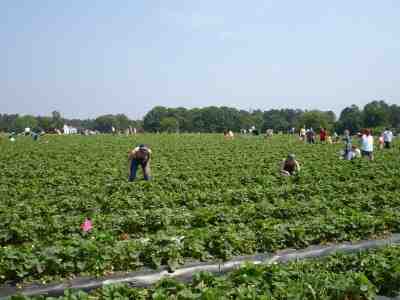
In the U.S. strawberries typically peak during April in Florida and Texas, May in the deep South, and in early June in middle sections and later June in the far North and Canada. Keep in mind that crops are ready at various times of the month depending on which part of the state you are located. In order to produce good local strawberries, producers depend on ideal spring weather conditions.
Before you leave to go to the farm:
- Always call before you go to the farm - strawberries are affected by weather (both rain and cooler temperature) more than most crops. And when they are in season, a large turnout can pick a field clean before noon, so CALL first!
-
Leave
early. On weekends, then fields may be picked clean by NOON!
-
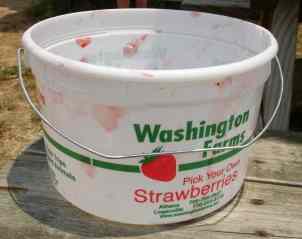 Most growers furnish picking containers designed
for strawberries, but they may charge you for them; be sure to call before you go to see if you need to bring
containers.
Most growers furnish picking containers designed
for strawberries, but they may charge you for them; be sure to call before you go to see if you need to bring
containers.
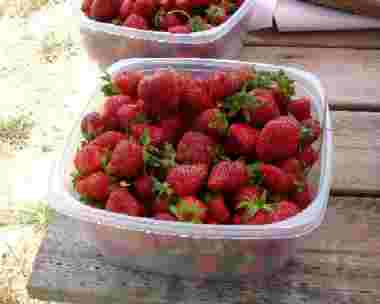 If you use your own containers, remember that heaping
strawberries more than 5 inches deep will bruise the lower berries.
Plastic
dishpans, metal oven pans with 3 inch tall sides
If you use your own containers, remember that heaping
strawberries more than 5 inches deep will bruise the lower berries.
Plastic
dishpans, metal oven pans with 3 inch tall sides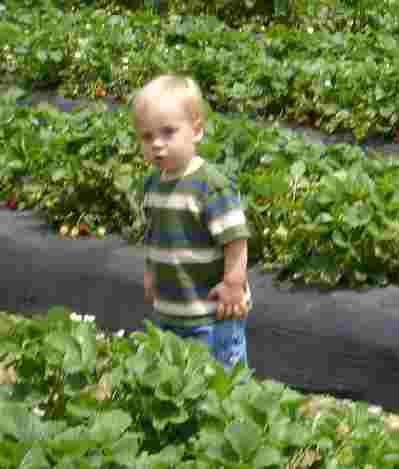 and large pots make good
containers. I like the Glad storage containers like the one at right.
and large pots make good
containers. I like the Glad storage containers like the one at right. -
Bring something to drink and a few snacks; you'd be surprised how you can
work up a thirst and appetite! And don't forget hats and sunscreen for the
sun. Bugs usually aren't a problem, but some deet might be good to bring
along if it has been rainy.
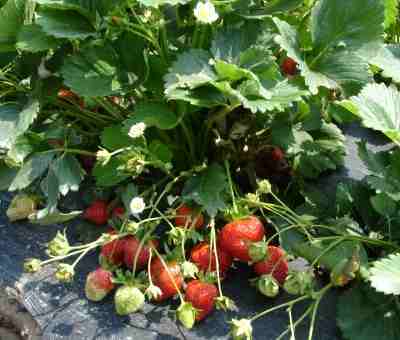
Tips on How to Pick Strawberries
- Grasp the stem just above the berry between the forefinger and the thumbnail and pull with a slight twisting motion.
- With the stem broken about one-half inch from
the berry, allow it to roll into the palm of your hand.

- Repeat these operations using both hands until each holds 3 or 4 berries.
- Carefully place - don't throw - the fruit into your containers. Repeat the picking process with both hands.
- Don't overfill your containers or try to pack the berries down.
General Picking Tips
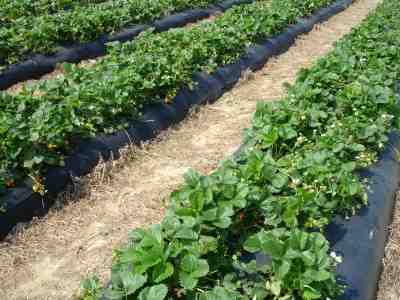 Whether you pick strawberries from your garden or at
a Pick-Your-Own farm, here are a few tips to keep in mind:
Whether you pick strawberries from your garden or at
a Pick-Your-Own farm, here are a few tips to keep in mind:
-
Be careful that your feet and knees do not
damage plants or fruit in or along the edge of the row.
- Pick only the berries that are fully red. Part
the leaves with your hands to look for hidden berries ready for harvest.
- To help the farmers, also remove from the plants
berries showing rot, sunburn, insect injury or other defects and place them
between the rows behind you. If they are left in the plants, the rot will
quickly spread to other berries.
- Berries to be used immediately may be picked any
time, but if you plan to hold the fruit for a few days, try to pick in the
early morning or on cool, cloudy days. Berries picked during the heat of the
day become soft, are easily bruised and will not keep well.
- Avoid placing the picked berries in the sunshine any
longer than necessary. It is better to put them in the shade of a tree or
shed than in the car trunk or on the car seat. Cool them as soon as possible
after picking. Strawberries may be kept fresh in the refrigerator for two or three, depending upon the initial quality of the berry. After a few
days in storage, however, the fruit loses its bright color and fresh flavor
and tends to shrivel.
- For interesting and fun strawberry facts and trivia from the California Strawberry Commission, click here!
When you get home
- DON'T wash the berries until you are ready to use them. Washing makes them more prone to spoiling.
- Pour them out into shallow pans and remove any mushed, soft or rotting berries
- Put a couple of days supply into the fridge, wash and cut the caps (green tops) off the others and freeze them up! (Unless you're going to make jam right away) See this page about how to freeze strawberries.
- If you like the strawberries you picked, ask the farm what variety they planted, and not the weather conditions the week or two before. The flavor of a strawberry is affected by the variety, the weather and the degree of ripeness when picked.
- Now, get ready to make strawberry jam. It is VERY easy - especially with our free strawberry jam instructions - they're illustrated and easy.
Strawberry Recipes, Canning and Freezing Strawberries
- How to freeze strawberries!
- Strawberry jam (with pectin) (uses less sugar or honey and less cooking)
- Strawberry jam (without pectin) (requires much more sugar and cooking)
- Strawberry (and other berry) jams without sugar
- Strawberry jelly
- Strawberry-rhubarb jam!
- Homemade strawberry ice cream (regular, low fat, nonfat, low sugar, vanilla and even gelato)
- Canning strawberries
- Make gourmet chocolate-covered strawberries
- How to make fruit juice - strawberry and other berries
- Strawberry pie filling
- Strawberry pie
- Easy Rhubarb-Strawberry pie
- Fig-strawberry jam
- Fig-strawberry jam, made with Jello gelatin
Strawberry Facts, Measurements and Tips
-
Picking the best strawberries:
Select firm, fully red berries. Strawberries DO NOT continue ripen after
they are picked! In the photo, only the berry on
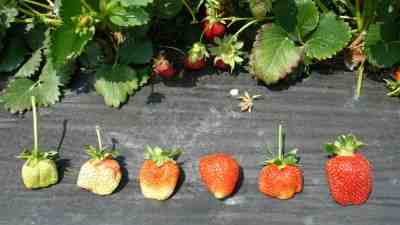 the far right is
completely ripe.
the far right is
completely ripe. - Strawberry festivals: Most areas that grow strawberries have a strawberry festival, at which you can taste all kinds of fresh strawberry foods, pies, jams, cakes - and most commonly, fresh strawberry shortcake. To find out where and when there is one near you, see this page for a list of strawberry festivals, sorted by state!
- Strawberries measurements: government agriculture
websites tell us that
1 quart = 2 pints = 4 cups and is about the same as 1 liter and
1 quart of fresh strawberries weighs 1 lbs to 1.25 lbs (or 450 to 600 g). Of course, the weight varies on variety and weather conditions.
1 quart is normally enough for 4 servings, although I'll admit my son can eat 1 pint by himself! - How much to pick? In general, 1 quart of fresh, whole, just-picked strawberries = approximately 3.5 cups hulled, whole berries. In other words, removing the caps/hulls and the occasional mushy berry means you lose 1/4 cup to 1/2 (it depends how much fruit you remove with the hull) or about 7 to 12% of every quart you pick.
- One cup of strawberries contains only about 50 calories
- U-pick strawberries are much healthier than store-bought. Consumer reports says store bought strawberries have so many pesticide and fungicide residues on they, that they don't recommend you eat them at all!
- U-pick strawberry farms typically sell berries by the pound. 1 lbs of fresh strawberries is about 2/3 of a quart.
- It takes about 10 to 15 minutes to pick a quart, if the berries are reasonably plentiful
- The strawberry plant adapts to wide variety of soil conditions, but does not tolerate drought well, and the berries quickly rot if the weather is rainy. For this reason, the plants are usually grown on raised beds through plastic mulch!
- Cultivation of strawberries began in Europe in the 1300's, but the berry only became very popular in the early 1900's in California.
- Do the math and be careful not to over-purchase as strawberries quickly mold when left at room temperature, and only last a couple of days in the refrigerator.
- You can easily freeze berries that you cannot use right away - just
wash, cut the hulls off and pop them into a ziplock bag, removing as much
air as possible. Those vacuum food sealers REALLY do a good job of
this! The berries will keep for many months frozen without air.
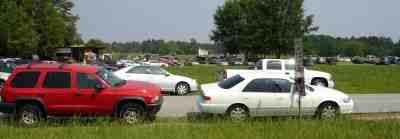
- Want to grow your own strawberries? Here's an article about how to: Strawberries are an Excellent Fruit for the Home Garden, HYG-1424-98!
- See this page for many more fun and interesting strawberry facts, nutritional information and trivia
Other weird strawberry facts
- Strawberries are the only fruit with seeds on the outside.
- Strawberries were originally called strewberries because the fruit was 'strewn' amongst the leaves of the plant.
- California is king of strawberry productions because: California produces 75 percent of the nation's strawberry crops; one billion pounds of strawberries each year. If all the strawberries produced in California in one year were laid berry to berry, they would go around the world 15 times. Each acre of land in California in strawberry production produces an average of 21 tons of strawberries annually, with a total of 23,000 acres of strawberries planted in California each year.
More conversions
1 pint (2 cups) of fresh whole strawberries
- = about 8 oz (1/2 lb) of strawberries
- = 2.25 cups of sliced strawberries
- = 1 cup pureed strawberries
- = 12-14 large strawberries
2 quarts of fresh strawberries are needed for a 9" pie
A 10 oz package of frozen berries is about the same as 1 cup of sliced fresh strawberries
References:
- University of Illinois Extension
- Driscolls
- Ohio State University Extension
- Strawberries-Average retail price per pound and per cup equivalent
Other Local Farm Products (Honey, Horses, Milk, Meat, Eggs, Etc.)
(NOT pick-your-own, unless they are also listed above)
- Farm markets and roadside stands
- Local Honey Finder
- Local Meat, Milk and Eggs
- Venues: Farms, Wineries, Orchards for your event, wedding or party
- Easter egg hunts
- Children"s consignment sales
- Fruit and vegetable festivals
- Winery tours and wine tastings
- Horse rides, stables, lessons, trails
- Maple Syrup farms and sugarworks
- Bed & Breakfasts on Farms, Wineries, Ranches and Orchards
- Pumpkin patches
- Corn mazes
- Zombie Paintball venues
- Christmas Tree Farms & lots
- Environmental resources
- Consumer fraud information
- Wholesale food sources
- Resources for Farmers
Looking for canning equipment and supplies?
Water bath canner with a jar rack
Pressure canners for gas, electric and induction stoves: Presto 23Qt or T-fal 22Qt
Canning scoop (this one is PERFECT)
Ball Blue book (most recent version)
Jars: 8oz canning jars for jams
Find Other types of farms:
Farm markets and roadside stands
Road trips and camping resources
Local Honey, apiaries, beekeepers
Consumer fraud and scams information
Home canning supplies at the best prices on the internet!
Maple Syrup Farms, sugarworks, maple syrup festivals
Environmental information and resources
Farms For Your Event for birthday parties, weddings, receptions, business meetings, retreats, etc.
Festivals - local fruit and vegetable festivals
Get the
most recent version of
the Ball Blue Book
With this Presto 23 quart pressure canner and pressure cooker, you can "can" everything, fruits, vegetables, jams, jellies, salsa, applesauce, pickles, even meats, soups, stews. Model 01781

You can make jams, jellies, can fruit, applesauce, salsa and pickles with water bath canners, like this Granite Ware 12-Piece Canner Kit, Jar Rack, Blancher, Colander and 5 piece Canning Tool Set

